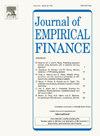Momentum is still there conditional on volatility-amplified pessimism
IF 2.4
2区 经济学
Q2 BUSINESS, FINANCE
引用次数: 0
Abstract
We present a representative agent model with probability weighting that predicts expected momentum returns decrease in market volatility and pessimism, and predicts the opposite for the equity premium. Hence, the model predicts that the expected market and momentum returns move in opposite directions and can be used to form a dynamic hedging strategy that conditions on market volatility and market pessimism. Our asset pricing model motivates an index of volatility-amplified pessimism (VAP) that predicts both momentum and market returns as well as a real-time trading strategy that uses the index to switch between the market and momentum portfolios. In high VAP states, the market generates high returns and Sharpe ratios, while momentum generates high returns and Sharpe ratios in low VAP states. Although most momentum strategies have recently disappeared we find that momentum is still there, conditional on the interaction between market pessimism and market volatility.
动能仍在,但前提是波动性放大的悲观情绪
我们提出了一个具有代表性的代理模型,该模型具有概率加权,可以预测市场波动和悲观情绪下的预期动量收益下降,而股票溢价则相反。因此,该模型预测市场预期收益和动量收益是反向运动的,可以用来形成以市场波动和市场悲观为条件的动态对冲策略。我们的资产定价模型激发了波动放大悲观指数(VAP),该指数预测动量和市场回报,以及使用指数在市场和动量投资组合之间切换的实时交易策略。在高VAP状态下,市场产生高回报和夏普比率,而在低VAP状态下,动量产生高回报和夏普比率。虽然大多数动量策略最近消失了,但我们发现动量仍然存在,条件是市场悲观情绪和市场波动之间的相互作用。
本文章由计算机程序翻译,如有差异,请以英文原文为准。
求助全文
约1分钟内获得全文
求助全文
来源期刊

Journal of Empirical Finance
Multiple-
CiteScore
3.40
自引率
3.80%
发文量
59
期刊介绍:
The Journal of Empirical Finance is a financial economics journal whose aim is to publish high quality articles in empirical finance. Empirical finance is interpreted broadly to include any type of empirical work in financial economics, financial econometrics, and also theoretical work with clear empirical implications, even when there is no empirical analysis. The Journal welcomes articles in all fields of finance, such as asset pricing, corporate finance, financial econometrics, banking, international finance, microstructure, behavioural finance, etc. The Editorial Team is willing to take risks on innovative research, controversial papers, and unusual approaches. We are also particularly interested in work produced by young scholars. The composition of the editorial board reflects such goals.
 求助内容:
求助内容: 应助结果提醒方式:
应助结果提醒方式:


